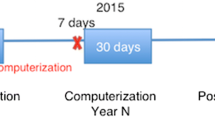Abstract
Objective: Evaluation of a computerized physician order entry in an Internal Medicine Department, with a unit-dose distribution system.
Setting: Pharmacy Department, Internal Medicine Department. S. Francisco Xavier Hospital, Lisbon, Portugal.
Method: This study was carried out in December 2001 and January 2002. After two years experience of the CPOE system, medication errors were evaluated prospectively, in an internal medical department of a 360-bed academic hospital. Data were collected once a week. Pharmacists reviewed all medical prescriptions as part of their routine work. Medication errors detected were recorded on a data collection form with a design based on the types of errors as defined by the American Society of Hospital Pharmacists (ASHP). Completed forms were reviewed and medication errors were classed according to ASHP guidelines.
Results: A total of 2268 orders were monitored (162 patients). In these orders, 73 medication errors (22.4% of the patients) were detected and documented (59 prescribing errors and 14 monitoring errors). The most common prescribing errors were deficiencies related to the right class but wrong drug (28.3%): omeprazole vs. ranitidine/sucralfate in stress ulcer prophylaxis; incorrect dose (30%) and unclear orders (13.3%). Errors related to incorrect frequency of administration (5%); maintenance of IV route (5%); duplicated drug therapy (11.7%); drug interactions (1.7%) and length of therapy (3.3%) were also detected. The 14 monitoring errors detected were failures to review a prescribed regimen for appropriateness and detection of problems.
Conclusions: Computerized prescription order entry has demonstrated effectiveness in eliminating medication errors related to transcribing and patient identification. Nevertheless, medication errors related to prescription and monitoring still occur. The use of clinical decision support systems and pharmacist involvement is vital to achieve maximum medication safety and reduce medication error rates.
Similar content being viewed by others
References
R Kaushal et al. (2003) ArticleTitleEffects of computerizes physician order entry and clinical decision support systems on medication safety A systematic review Arch Intern Med 163 1409–16 Occurrence Handle10.1001/archinte.163.12.1409 Occurrence Handle12824090
T. Wesbit (2001) ArticleTitleImplementation and pharmacoeconomic analysis of a clinical staff pharmacist practice model Am J Health Syst Pharm 58 784–90 Occurrence Handle11351918
American Society of Hospital Pharmacists. ASHP guidelines on preventing medication errors in hospitals. Am J Hosp Pharm 1993; 50:305–14
A Bobb K Gleason et al. (2004) ArticleTitleThe epidemiology of prescribing errors The potential impact of computerized prescriber order entry. Arch Intern Med 164 785–92
M. Graber (2004) ArticleTitleThe safety of computer-based medication systems Arch Intern Med 164 339–40 Occurrence Handle10.1001/archinte.164.3.339-b Occurrence Handle14769634
J. Carmenates (2001) ArticleTitleImpact of automation on pharmacist interventions and medication errors in a correction health care system Am J Health Syst Pharm 58 779–83 Occurrence Handle11351917
Second Consensus of Granada on Drug Therapy Problems. Ars Pharmaceutica 2002; 43(3–4):175–84
L. Norton (2001) ArticleTitleContinuing education – medical and medication errors: a partial summary of reports by the Institute of Medicine and the Quality Interagency Coordination Task Force J Manage Care Pharm 7 IssueID1 62–8
SL. Ellis (2000) ArticleTitleTypes of interventions made by clinical pharmacists in the IMPROVE Study Pharmacotherapy 20 IssueID4 429–35 Occurrence Handle10.1592/phco.20.5.429.35055 Occurrence Handle10772374
CA. Bond (2000) ArticleTitleMedications errors in the United States Hospitals Pharmacotherapy 21 IssueID9 1023–36
Author information
Authors and Affiliations
Corresponding author
Rights and permissions
About this article
Cite this article
Mirco, A., Campos, L., Falcão, F. et al. Medication Errors in an Internal Medicine Department. Evaluation of a Computerized Prescription System. Pharm World Sci 27, 351–352 (2005). https://doi.org/10.1007/s11096-005-2452-z
Issue Date:
DOI: https://doi.org/10.1007/s11096-005-2452-z




